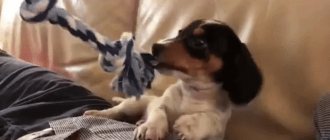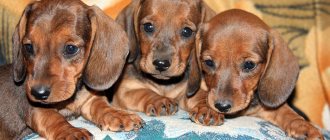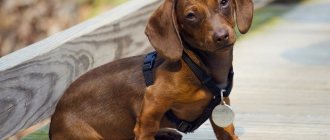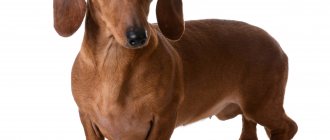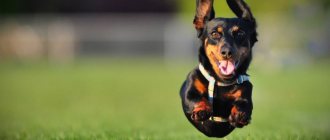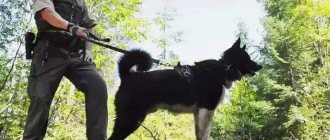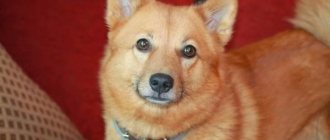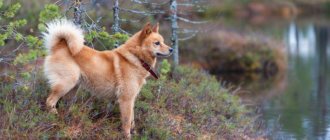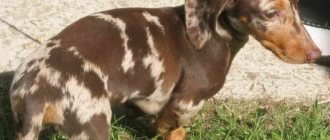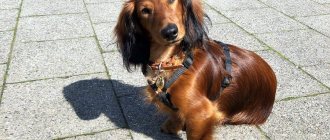At the beginning of the 20th century, these restless miniature dogs were one of the main characters in cartoons dedicated to the German nation. And all because the German Emperor Wilhelm II loved this breed so much that he kept five of its representatives of different sizes and colors.
The tender attitude towards dachshunds was “transmitted” to members of the political elite of Germany during the Second World War. As a result, hatred of the Nazis spread to dachshunds, which were disliked throughout Europe for a long time after the victory over fascism.
Over time, passions subsided and now the dwarf dachshund is popular in many countries of the world and is considered an intelligent and loyal pet.
Brief history of origin
Officially, the dwarf dachshund is a descendant of the short Braccus. Its small stature and short legs gave it advantages for working in burrows. In addition, miniature dogs did not take up much space and required lower maintenance costs, so they were especially loved by hunters.
At the end of the 18th century, mini dogs acquired modern features and were divided according to size, coat type and working qualities. Nowadays, individuals are isolated for hunting, exhibitions and home keeping as pets.
Interesting Facts
1) A male dachshund named Waldi became the symbol of the Olympic Games in 1972. It turned out that the outline of the Olympic marathon route resembled a mini-dachshund. This is the only pet that has received the honor of being the mascot of the Olympics.
2) Dwarf dachshunds are very “talkative”: they like to bark, “sing”, and whine.
3) These small dogs are real guards, they have an innate gene for aggressiveness, so they are considered one of the most unfriendly breeds.
4) Dwarf dachshunds have a very strong spirit of competition, so they become good athletes and often participate in dog racing.
5) The long, streamlined body shape of dachshunds puts uneven pressure on their limbs, so any jumping is dangerous. Despite this, dwarf dogs love this activity very much.
Breed description, standards and appearance
The miniature dachshund is the second largest of the three height varieties. The size of an adult dog is characterized by two parameters: chest volume (30-35 cm) and weight (4-5.5 kg).
Description of the breed “dwarf dachshund” is included in the unified group standard (number 4 according to the ICF classification).
- The head is long, smoothly connected to the muzzle, without a sharp stop, tapers evenly towards the nose, but does not become pointed. The brow ridges are well defined.
- The muzzle is long and wide at the base. The jaw is strong, with a full set of teeth. Scissor bite.
- The nose is large.
- The eyes are round and medium in size. The iris is brown (dark to hazel).
- The ears are set high, hanging down at the temples, rather long, soft, and pushed forward.
- The body is long, elongated, streamlined, with a smooth topline, organically connected to the withers. The croup is sloping. The back is straight, the lower back is muscular. The belly is tucked in. The chest is voluminous, well descended.
- The neck is curved, muscular, with a convex nape.
- The tail is a continuation of the line of the back, the tip is slightly curved towards the top.
- The limbs are muscular, straight, short, parallel, not narrow in stance. The movements are energetic and sweeping. Paws are rounded.
Varieties
There are three height variations for the Dachshund breed. In addition to the miniature dwarf (up to 5.5 kg in weight), there is also a standard one (up to 9 kg) and the smallest rabbit (up to 3.5 kg). In addition to height, the coat is also different.
You can find out more about the breed in the article “All about the Dachshund”.
Individuals of each size may have smooth-haired, wire-haired or long-haired coat types.
All other characteristics (except weight and hair) of the dwarf species are similar to their counterparts.
Color and coat type
By color, a dwarf dachshund can be:
- single-color (red, brown, black);
- bicolor (black or brown with reddish tan markings on the face, paws, ears);
- spotted or marbled (reddish, white or gray spots appear on the main dark color).
Species that differ in coat type are bred separately. For example, crossing smooth-haired and wire-haired individuals is not allowed. The short coat should be shiny and fit tightly to the skin. Coarse hairs of medium length form characteristic fringes on the ears, tail, body and beard. The long-haired dwarf dachshund has a long, straight coat with a soft undercoat.
Important! Wire-haired and long-haired mini dachshunds require more care than smooth-haired ones.
Development in the first month
In the first month, wire-haired dachshund puppies grow very actively. The most important changes by day are presented in the table below.
| Days | Changes |
| 1-3 | Puppies cannot see or hear yet, but they have a developed sense of smell. |
| 4 | The sense of smell increases and hearing begins to appear. |
| 5-7 | The nasal lobe turns dark. |
| 8-9 | Body weight begins to actively increase. |
| 10-14 | The eyes open, the puppy learns to move independently. |
| 15-20 | The first baby teeth appear. |
| 21-30 | The puppies begin to move more and become more active. |
Character and behavior
By nature, dachshunds are very kind, flexible, and cheerful. They are ready to follow their owner all day long.
They love training, jogging and hunting. The instincts of these miniature dogs are still preserved unchanged. Therefore, owners are often faced with a dug up garden, chewed things and “surprises” in the form of dead animals on the doorstep of the house.
Dwarf dachshunds are very smart, however, they are often cunning and stubborn. The mini-pet can simply lie down in the middle of the street if it does not want to go further. This trait can be combated through training.
Dwarf dogs also have protective instincts, which makes them good guards. Their mistrust often takes over, which causes conflicts with strangers and dogs.
Breed and children
The dwarf dachshund is reserved towards children.
She gets along with teenagers and loves to play, but she doesn’t like kids and doesn’t tolerate their pranks and mockery. Therefore, it is recommended to have such a miniature pet for those families in which children have reached 8-12 years of age.
But if the puppy grew up with a newborn child, then they will develop a long-lasting and strong friendship.
Learning ability
The dachshund is easy to train - it is smart. Requires a consistent approach to training and thoughtful commands. First of all, train your dachshund puppy to:
- to the nickname;
- to the leash;
- to the collar;
- to the muzzle.
Next, teach the commands “Come to me”, “Sit”, “Lie down”, “Near”, “”. Require your dog to maintain discipline in the house. Once you have prohibited climbing on the bed, stop the dog every time it tries to lie on the pillows. Be consistent in your requirements.
If your dachshund is stubborn, enforce the command and take a break. But don’t fall for the dog’s tricks - distinguish between real fatigue and pretend fatigue.
After completing a general training course, you can train the dog to hunt game if you plan to use it for hunting.
How to choose the right puppy?
Today it is very easy to purchase a dachshund puppy in Moscow and other large cities: many nurseries, clubs and individuals are engaged in breeding.
To get a healthy, adequate dwarf dachshund puppy, you need to find out about the breeder in advance and read the owners’ reviews about him. You should also ask for documents, a breeding license, medical certificates and the pedigree of the parents.
The best option is to meet the mom and dad of the future mini-pet.
If you are given a choice of several puppies, you should pay attention to the one that reacted most actively to the arrival of guests. You can say an invented nickname, and whoever responds will become a true friend. A dwarf baby must be healthy, without obvious pathologies or non-compliance with standards.
What to do if your dachshund's weight is below normal
If a person's height, weight, or size lags behind schedule by more than 20%, this is a cause for concern. In this case, you need to contact a veterinarian and have your pet examined. In the absence of pathologies, the taxi driver’s diet is revised to increase the proportion of protein products, vitamin and mineral supplements, raw and boiled vegetables and fruits are introduced. You should take them for walks in the fresh air more often and regularly give them anthelmintics.
Puppies
Dwarf dachshund puppies resemble a smaller copy of an adult dog: a long body, drooping ears, intelligent eyes. The main difference is the wrinkled short muzzle, which over time takes on the shape of an elongated wedge.
The color changes slightly with age, the coat may darken or become spotted.
They try to acquire exhibition specimens at the age of 5-6 months, after the completion of the formation of the body.
Dwarf puppies for hunting are purchased during the teenage period of their life (6-8 months) in order to track the development of skills and the strength of instincts.
How old do dachshunds grow?
Before growing to the standard, the dachshund goes through several stages of development:
- intrauterine – from mating to birth of the puppy;
- suckling – from birth to the end of breastfeeding;
- childhood and adolescence – from 6 weeks to 0.5 years;
- youth – from 0.5 to 1.5 years;
- adult dog - after 1.5 years.
Estrus in females and puberty in males occurs by the age of one year, but this does not mean that they are ready for mating. For breeding, the most suitable age is 2 years. At one and a half years, taxi drivers have a fully formed skeletal and muscular system, so height and weight measurements are carried out during this period.
Care and maintenance
The thoroughness of caring for dachshunds is based on the length and type of coat. The most unpretentious are smooth-haired individuals. Although the dwarf breed is generally undemanding, it gets along well both in an apartment and in a private house.
Important! The main criterion for care is veterinary care. Dogs are prone to serious diseases that require timely diagnosis and treatment.
The right diet
Although the dwarf dachshund is a small dog, it eats a lot. If the amount of food is not limited, obesity and heart and liver problems are guaranteed. For mini-dachshunds, dry ready-made products with an already adjusted dose and vitamin complex are recommended.
Super-premium low-carb dog foods are suitable. Among well-known brands there are special lines for dwarf dachshunds (for example, from the company “RoyalCanin”). If you cannot purchase such food, it is better to opt for dietary granules for medium-sized pets with high activity.
Natural nutrition is beneficial if you carefully select products. The serving should correspond to the following proportions: 40-50% protein, 30-40% carbohydrates, 10-20% fat. At one time, an adult dwarf dachshund should eat 100-150 g of food. A total of 2 feedings per day are required, puppies – 4-5 (40-60 g each).
Allowed foods for dwarf dachshunds include lean, boneless meat, cottage cheese and kefir, apples, carrots, zucchini, buckwheat, oatmeal and rice. Sausages, fried and smoked foods, flour products, sugar, and butter are prohibited.
Walking and physical activity
In dwarf dachshunds, the load on the spine is less than in standard ones. However, their limbs are not adapted for active jumping or long descents and ascents. To avoid problems with bones and joints, it is important not to allow your pet to jump a lot, walk up stairs independently, or train on high agility tracks.
Dwarf dachshunds are very active. They are used to hunting for 1.5-2 hours, constantly being on the move, tracking down prey. For this reason, an adult pet needs a two-time walk for 60-90 minutes with active training 3-4 times a week.
Children walk for 30-40 minutes, choosing an area without hills and mountains. Dwarf puppies get tired faster and may ask to be held. They should not overload their paws and spine so as not to start the deformation process.
Training and education
A miniature dachshund needs not only specialized training for hunting, but also comprehensive education. Without proper socialization, the pet will become angry, aggressive, and distrustful. Therefore, from an early age, dwarf puppies are taught to restrain their emotions.
Miniature dachshunds can cheat to avoid punishment. The owner must accept this feature while still trying to re-educate his pet. Don't yell at the dog or hit him. It is better to use a motivation method (reward with treats, deprivation of games or toys).
You need to teach your miniature pet to walk on a leash, tolerate walking, go to the toilet outside, and eat on a schedule. In addition, the baby must learn the commands “near”, “sit”, “lie down”, “no”, “place”.
Important! The dwarf dachshund is a hunting breed that requires periodic testing of its skills. Organized field “trainings” on dummies or short walks in the forest, where the dog can prove himself, are perfect.
Care and hygiene
Smooth-haired dwarf dachshunds are the easiest pets to care for and do not require trimming or frequent combing. Every day after walks, the short coat is wiped with a damp towel. During the molting season, dead hairs are removed with a glove brush.
The wire-haired dwarf dachshund is trimmed (hair plucked) twice a year. It is better to entrust this matter to a professional groomer. Long-haired miniature dogs are combed daily with a long-tooth comb to avoid matting.
Dwarf pets are bathed every 10-15 days and when they are heavily soiled, but their paws are always washed after walking. The ears are examined for the presence of discharge and inflammatory formations, and cleaned of wax with cotton pads. Clean teeth with chewy treats. Nails are trimmed once every trimester if they do not grind down on the asphalt.
Important! Every 3-4 months, the dwarf dachshund needs to prevent helminth infection. And in the warm season, treatment for ticks and fleas is required.
Factors influencing growth
The development of dogs is influenced by a complex of factors:
- Genetic predisposition, quality of pedigree.
- Keeping a mother dog during pregnancy.
- Quality of mother's milk, duration of feeding.
- Phys. activity. A developing body needs to spend at least 3 hours a day outside. The first walk is a week after the 2nd vaccination. First, the puppy is carried out in warm weather, and over time is taught to walk on a leash or harness.
- Environment. Constant stress, noise, screams, and an alarming environment are extremely negative factors for a puppy. Their consequences range from aggressive behavior to developmental inhibition.
Vaccinations and susceptibility to disease
Miniature dachshunds are hunting dogs that, even without special training, will exhibit the qualities of a bloodhound. Many of them often come into contact with wild animals and rodents, which is why they especially need protection from dangerous infectious diseases. Nothing will deal with the virus better than vaccination.
Important! All miniature puppies are defenseless against the attack of a serious virus. They have weak immunity and no innate resistance to diseases. The only exceptions are those babies who were born from a mother who had been ill.
There is a division into mandatory and optional vaccinations for miniature dogs. Without the first, the animal cannot be bred, transported across the border, and in some countries, cannot be walked in public places. These include vaccination against distemper, enteritis, hepatitis (complex injection at 2.5 months), leptospirosis and parainfluenza (at 3-3.5 months), rabies (at six months).
To maintain immunity stability, a one-time booster vaccination against all viruses is carried out annually.
The main problem of dwarf dachshunds is deformation of the spine and joints of the limbs. During selection, these dogs acquired a striking external feature - an elongated, low body. This mutation is functional in hunting, looks original, but is harmful to general health. Owners are faced with the following diseases in mini-dachshunds:
- obesity;
- diabetes;
- epilepsy;
- cataract;
- joint dysplasia;
- displacement of intervertebral discs;
- intervertebral hernia;
- genitourinary system infections;
- heart failure.
How long do miniature dachshunds live?
A dog's life is much shorter than a human's, because 1 year of a pet is equivalent to 7 years of its owner.
The average life expectancy of dwarf dachshunds is 12-15 years. This period may be shortened or increased depending on the quality of care: nutrition, veterinary care, physical activity.
If all maintenance rules are followed, a dwarf dachshund can live up to 17-18 years.
Interesting! The dwarf breed occupies a leading position in longevity. In 2009, the oldest dog, according to the Guinness Book of Records, was the miniature dachshund Chanel, who lived for 21 years.
Pros and cons of the breed
The dwarf dachshund has long occupied an honorable place in the ranking of the most popular miniature pets. It does not require special care or highly specialized training. But, like all breeds, mini-dachshunds have their advantages and disadvantages.
| pros | Minuses |
| Endurance and activity | The need to search, dig |
| Loyalty, devotion to family, obedience | Small dachshunds are prone to gaining excess weight |
| Developed intelligence and quick learner | Often there are serious problems with the spine |
| Variability (different sizes, coat types, working abilities) | Jealousy and touchiness |
| Dwarf dachshunds are unpretentious in keeping | Included in the top 10 aggressive and emotionally unstable breeds |
If you need a faithful and devoted pet of miniature size, you can safely purchase a dwarf dachshund.
These miniature dogs will support their owner in all endeavors: sports, hunting and even creativity. It’s not for nothing that funny videos are made with dachshunds for social networks - animals with their owners become real Internet stars.
Health
It is not particularly strong in a miniature dachshund. Above, we promised to tell you why representatives of the breed should not jump. This is fraught with spinal injuries. Up to displacement or damage to the spinal discs.
Cataracts are a common companion of dachshunds. They may even have problems with their eyes.
Representatives of the breed are also prone to enteritis. It occurs due to poor nutrition and frequent overeating.
